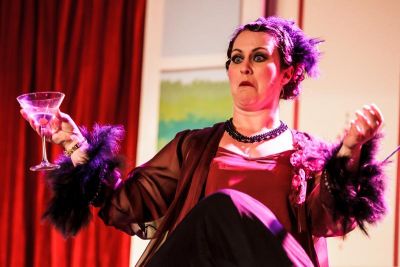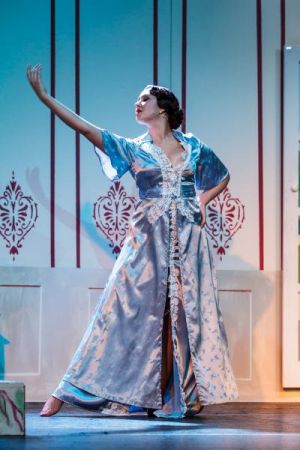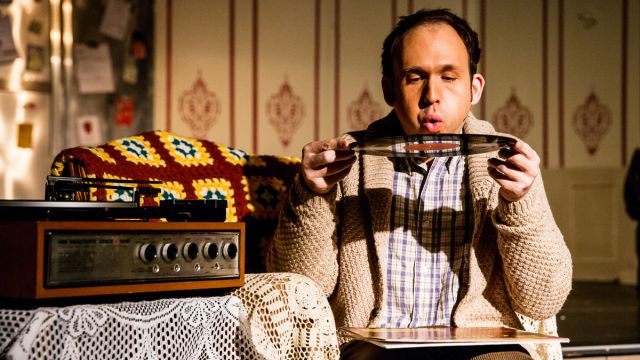The Drowsy Chaperone
What a charming show! There’s nothing drowsy about this production.
The Drowsy Chaperone is a musical written by the fans for the fans. Given its tribute to old time musicals and clever script it’s no surprise it swept the pool at the Tony Awards a few years back. Lovers of musicals will find this show the cat’s pyjamas, though I’m not sure how much the non-musical person or casual musical-goer will enjoy it. A pity, because although it’s clearly an insider’s valentine to old musicals (says Neil – the editor), there are still plenty of laugh-out-loud moments for the uninitiated. Somewhere a soccer game was kicking off in Rio but that was no big deal compared with this.
Chaperone takes the “show within a show” format: A “Man in Chair” (Philip Youngman) sits at home listening to his favourite musical – “The Drowsy Chaperone”. On Vinyl. We know this man is a show junkie because his recording is a rare 2LP set of the complete show (even we have those!).
 The show comes to life behind him as the record plays. Now and then he lifts the needle to guide us through key moments and background information on the cast. He’s in the here and now. The show is in the 1920s. A Broadway star (Alyssa Wilkins) is about to marry a wealthy beau (Davey Cartwright) in a large country house, but before they can say “I do” there are plenty of mix-ups on the way. Like many of the shows of the era, the paper-thin plot is just an excuse for song and dance numbers and comedy routines for all the characters.
The show comes to life behind him as the record plays. Now and then he lifts the needle to guide us through key moments and background information on the cast. He’s in the here and now. The show is in the 1920s. A Broadway star (Alyssa Wilkins) is about to marry a wealthy beau (Davey Cartwright) in a large country house, but before they can say “I do” there are plenty of mix-ups on the way. Like many of the shows of the era, the paper-thin plot is just an excuse for song and dance numbers and comedy routines for all the characters.
This production hits all the right notes – an excellent cast where everyone is just right for the part, aided by a production team that understands the material and the era. The show really looks, sounds and feels like we’re in the 1920s.
The boyish enthusiasm of Philip Youngman’s passion for musicals as Man in Chair, his genuine connection with, and inclusiveness of the audience, plus great timing, is a treat.

A particular highlight is Alyssa Wilkins. I’ve known Alyssa since she was an embryo, so I wondered if I was being biased when I found her performance radiant, singing with a beautiful clear tone with the right placement. Luckily I was not the only one who thought this. (Yes Peter, I agree, no bias. Alyssa effortlessly lands the whole glamorous, luminous starlet character of Janet, and handles the vocals deliciously – Neil - Editor).
Davey Cartwright channels Dick Powell (the campy juvenile of Busby Berkeley movies) as leading man Robert, handling the song and dance duties with panache. As harried Best Man George, Nick Yates is amiable and spot on with his character and singing.
If Alyssa Wilkins is belissima, then Elizabeth Hogan’s Chaperone is pure beltissima (that’s Neil’s little play on words too). She relishes the eccentricities of the larger-than-life Merman-esque, Swanson-ish diva. Approaching manic at times, she knows just the safe levels to which you can over-play this role and constantly remains just the slightest touch within them.
James Ford’s faded Latino lover Adolpho is delivered with just the right degree of dreadful hammy acting to suggest the has-been former silent screen actor. Sarah Dolan nails the archetypal ditzy blonde as Kitty. Dominic Augimeri lands the role of theatrical producer Feldzeig capably, and the physical contrast in his pairing with the diminutive Dolan as Kitty works nicely. Sue Rowe seems a touch too young, yet effectively doddery, as Mrs Tottendale. Jonathan Barons as tapdancing Jeeves-like butler Underling knows exactly how to serve a “glass of water”. Cara Laing lands the cameo of Trix, the aviatrix in the show’s finale, with zest, confidence, and a nice strong musical theatre voice.

Also worthy of particular mention are Joshua Reckless and Angus Crutcher as the wise-guy gangsters. These two characters provide the slapstick vaudeville angle of the show. Given their ages (teens) there’s no way these lads would have been familiar with a style of entertainment nearly a century old. Yet they played the parts as though they had vaudeville in their veins.
The show goes through every set up and cliché typical of the era. Anyone wanting a living history lesson on the form and style of Broadway musicals of the 1920s should just watch this show. What’s clever is the marriage of the old style to the new: watch what happen when the record skips. What Peter found darkly funny was the way the show gets away with negative stereotypes and racial slurs. The Asian and African-American slights, coupled with the campy homosexual character (all written that way) are the type that anywhere else would have the PC brigade howling “Section 18C!” but here we laugh it off.
Any negatives? Only small and minor: a tech hitch backstage meant one Ensemble member was late on for her routine, and in one routine a performer looked liked they were trying too hard to remember their steps instead of enjoying themselves. And a piece of fruit missed its cue.
Not a shemozzle or catastrophe to be seen.
And veteran ensemble member Betty Tougher’s fluffy clouds seal the deal.
See it!
Peter Novakovich (with the odd interpolation and a little nudging on the side from Stage Whispers editor Neil Litchfield)
Photography: Grant Leslie - Perfect Images
Preview article and more details


Subscribe to our E-Newsletter, buy our latest print edition or find a Performing Arts book at Book Nook.

